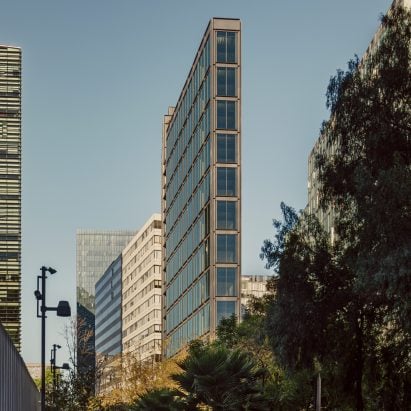HEMAA uses black steel for narrow skyscraper in Mexico City
Local studio HEMAA has completed the narrow, 13-storey Ferrocarril de Cuernavaca 780 with steel, concrete and glass on a skinny, post-industrial lot in Mexico City.Located between a street and the remnants of the Ferrocarril de Cuernavaca Railroad, the 9,465 square metres (101,874 square feet) Ferrocarril de Cuernavaca 780 building was designed as a skinny wedge on an underutilized property in the Polanco neighbourhood.HEMAA has completed the narrow Ferrocarril de Cuernavaca 780 building in Mexico City. Top photo by Rory Gardiner"It required an act of imagination to envision the emergence of a graceful tower that would deftly adapt to the challenging terrain," the HEMAA team said."Comparable to tenacious plants thriving amidst adversity, this tower would unfold, defying expectations."In addition to the site constraints, the narrow form resulted from a reinterpretation of classical architectural elements, incorporating the golden ratio in multiple places and dividing out into a base, shaft and capital through modulations and windows.It sits on a narrow plot next to a former railroadThe use of a black structural steel facade selected as a nod to the area's industrial history that has risen from a peripheral service neighbourhood to a vibrant area accommodates Mexico City's seismic regulations while allowing the floors to be free of columns.Glazing wraps almost entirely around the building, bringing in natural light from every angle and connecting the spaces to their surroundings.The materials reference the industrial history of the area"Depending on the viewer's vantage point and the time of observation, its shape gracefully metamorphoses, offering a myriad of unique interpretations," the team said. "Its unequivocal identity creates an ideal backdrop for the tower to assume a vibrant existence once it becomes inhabited."The skyscraper includes a ground-floor commercial space ideal for a coffee shop on the east corner of the building two glazed entries that create a see-through enfilade between the north and south facades, and a circulation core complete with a glazed robotized pallet system and elevators on the west side of the building.Two glazed entries create a enfilade for the ground floorEmbracing its responsibility toward public space, the design dedicates the southern portion of the site to public space, connects to the adjacent park and encourages interaction with the envisioned ground floor commercial space. This footprint reduction narrows the width of the building even further, rather than maximizing the available land.Below ground, 13 subterranean levels house storage and maintenance spaces while a robotic parking system accommodates 126 parking spaces in two parking cabins.The insides of the structure were left relatively sparseAbove, the typical floors are reduced to include only the essential egress and restroom facilities. The remainder of the glazed space is available for future tenant build-outs.On the 13th floor, the exterior wall steps back to form a roof terrace that offers panoramic views of the Mexico City skyline and Chapultepec Park.Read: Seven narrow New York townhouses making the most of urban spaceThe LEED-certified building includes advanced insulation and HVAC systems, high-efficiency lighting, rainwater harvesting and efficient plumbing fixtures, to ensure optimal energy usage, reduce carbon emissions and conserve water."Indoor environmental quality is a top priority, with ample natural lighting and effective air replacement promoting occupant health and well-being," the team said."The building's design encourages a connection to nature, with large windows, a rooftop garden, and outdoor gathering areas that enhance the overall user experience."It features a rooftop gardenHEMAA recently completed a nuanced steel structure of a lakeside gathering pavilion outside Mexico City, as well as a pair of stone houses in the Jardines del Pedregal neighbourhood and the renovation of a mid-century Augusto H lvarez house in Mexico City.The photography is Csar Bjar unless otherwise noted.Project credits:Architecture: HEMAADesign and construction team: Santiago Hernndez Matos, Alejandra Tornel Cahue, Jos Miguel Fainsod Castro, Jos Pedro Lpez Gonzlez, Alonso Snchez Toscano, Adriana Aguirre Becerra, Andrea Motilla Chvez, Daniela Parra Orozco, Jos Miguel Santivaez Gmez, Juan Octavio Ferreira, Mnica Garca Cruz, Patricio Salgado RodrguezStructural engineer: PESAElectric engineer: DECPlumbing engineer: Garza MaldonadoHVAC engineer: CYVSASpecial engineer:TecnoBuildingsLandscape design: DLC ArchitectsLEED certification comissioning: Alejandro Trillo + Gabriel MoralesArchitectural model: Taller Cuatro CuartosOthers: Omar Sad / Augusto lvarezThe post HEMAA uses black steel for narrow skyscraper in Mexico City appeared first on Dezeen.


